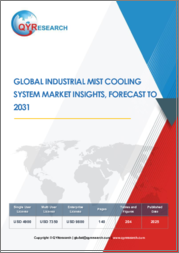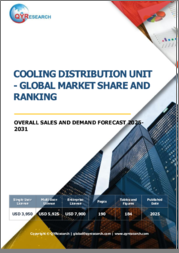
|
시장보고서
상품코드
1518506
흡수식 냉각 시스템 시장 규모 : 제품 유형별, 열원별, 냉각 능력별, 예측(2024-2032년)Absorption Cooling System Market Size - By Product Type, By Heat Source, By Cooling Capacity & Forecast 2024 - 2032 |
||||||
세계의 흡수식 냉각 시스템 시장은 탄소발자국을 삭감하고, 에너지 효율이 높은 냉각 솔루션을 우선하는 노력의 증가에 의해 2024-2032년 CAGR 4.5%에 달합니다.
친환경 냉매를 사용하고 기존 방식보다 에너지 소비가 적은 것으로 알려진 이 시스템은 전 세계 지속가능성 목표에 부합하는 것으로 알려져 있습니다. 전 세계 산업계와 정부가 환경 보호에 대한 노력을 강화함에 따라 흡수식 냉방 시스템에 대한 수요가 증가할 것으로 예상됩니다. 이러한 추세는 다양한 분야에서 보다 효율적이고 친환경적인 냉각 기술로의 전환을 반영하고 있으며, 이는 시장 성장을 크게 촉진할 것입니다.
예를 들어 에머슨은 2023년 10월 유럽 중소형 소매점을 위한 모듈형 CO2 스크롤 냉동 유닛을 출시하여 냉동 효율과 지속가능성을 강화했습니다. 기존 대체품에 비해 지구 온난화 지수가 낮은 것으로 알려진 CO2(R744) 냉매를 활용함으로써 에머슨은 규제 요건과 친환경 솔루션에 대한 소비자 선호도를 모두 충족시키고 있습니다. 이러한 움직임은 기술 혁신과 시장 성장에 박차를 가하고 흡수식 냉각 시스템을 지속가능한 소매점용 냉장 시스템으로서 매우 중요한 위치를 차지할 것으로 보입니다.
리튬 브로마이드-물 흡수 시스템은 효율적인 냉각 능력과 상업 및 산업 분야에서의 광범위한 응용으로 인해 2032년까지 상당한 성장을 이룰 것으로 예상됩니다. 이 기술은 대규모 냉각 요구 사항에 탁월하며 기존 압축 시스템에 비해 에너지 효율과 환경 지속가능성이 높습니다. 탄소발자국 감소와 에너지 절약에 대한 관심이 높아지는 가운데, 이러한 시스템은 안정적인 냉각을 제공하는 신뢰성을 바탕으로 지속가능한 냉각 솔루션 시장 전망에서 선호되는 선택이 되고 있습니다.
제약 분야는 의약품 및 백신 보관에 대한 엄격한 온도 관리 요구로 인해 2024-2032년 상당한 성장이 예상됩니다. 이러한 시스템은 유해한 냉매를 사용하지 않고 정확하고 신뢰할 수 있는 냉각을 제공하며, 세계 지속가능성 목표와 규제 기준에 부합합니다. 의약품 물류 분야에서는 안전하고 효율적인 보관 솔루션에 대한 수요가 증가하고 있으며, 흡수식 냉각 시스템은 공급망 전반에 걸쳐 기밀 의약품의 무결성과 유효성을 보장하고 일관된 온도를 유지할 수 있다는 점에서 두드러집니다.
유럽의 흡수식 냉각 시스템 시장 점유율은 엄격한 환경 규제와 에너지 효율에 대한 관심으로 인해 2024-2032년 적절한 CAGR을 보일 것으로 예상됩니다. 이 지역에서는 지속가능한 기술의 적극적인 채택과 재생 에너지 인프라에 대한 투자가 시장 성장을 가속하고 있습니다. 또한 친환경 냉각 솔루션에 대한 인식 증가와 정부의 지원 노력은 흡수식 냉각 시스템 산업에서 유럽의 두드러진 지위와 세계 도입 및 기술 혁신에 중요한 기여를 하고 있습니다.
목차
제1장 조사 방법과 조사 범위
제2장 개요
제3장 업계 인사이트
- 에코시스템 분석
- 밸류체인에 영향을 미치는 요인
- 이익률 분석
- 파괴
- 향후 전망
- 제조업체
- 유통업체
- 소매업체
- 규제 상황
- 영향요인
- 촉진요인
- 산업의 확대
- 태양에너지 발전 흡수식 냉동기의 채택률 증가
- 상업 빌딩, 데이터센터, 산업시설에서 냉각 수요의 증가
- 업계의 잠재적 리스크 & 과제
- 기존 압축식 냉동기에 비해 높은 초기 투자
- 촉진요인
- 소비자의 구매 행동 분석
- 소비자 동향
- 구매 결정에 영향을 미치는 요인
- 소비자의 제품 채택
- 선호 유통 채널
- 희망 가격대
- 성장 가능성 분석
- Porter의 산업 분석
- PESTEL 분석
제4장 경쟁 구도
- 서론
- 기업 점유율 분석
- 경쟁 포지셔닝 매트릭스
- 전략 전망 매트릭스
제5장 시장 추산·예측 : 제품 유형별, 2021-2032년
- 주요 동향
- 암모니아-물 흡수 시스템
- 브롬화 리튬-물 흡수 시스템
- 기타
제6장 시장 추산·예측 : 열원별, 2021-2032년
- 주요 동향
- 천연가스
- 증기
- 온수
- 폐열
- 태양에너지
제7장 시장 추산·예측 : 냉각 능력별, 2021-2032년
- 주요 동향
- 소형(100톤 미만)
- 중형(100-500톤)
- 대형(500톤 이상)
제8장 시장 추산·예측 : 최종 용도별, 2021-2032년
- 주요 동향
- 식품 및 음료
- 의약품
- 화학·석유화학
- 발전소
- 데이터센터
- 폐수 처리
- 기타
제9장 시장 추산·예측 : 유통 채널별, 2021-2032년
- 주요 동향
- 직접 판매
- 간접 판매
제10장 시장 추산·예측 : 지역별, 2021-2032년
- 주요 동향
- 북미
- 미국
- 캐나다
- 유럽
- 독일
- 영국
- 프랑스
- 이탈리아
- 스페인
- 기타 유럽
- 아시아태평양
- 중국
- 인도
- 일본
- 한국
- 호주
- 기타 아시아태평양
- 라틴아메리카
- 브라질
- 멕시코
- 기타 라틴아메리카
- 중동 및 아프리카
- UAE
- 사우디아라비아
- 남아프리카공화국
- 기타 중동 및 아프리카
제11장 기업 개요
- Thermax Limited
- Kirloskar Pneumatic Company Ltd
- Trane Technologies plc
- Johnson Controls, Inc.
- Carrier Global Corporation
- Robur Corporation
- LG Electronics, Inc.
- Shuangliang Eco-Energy Systems Co. Ltd.
- Kawasaki Thermal Engineering Co., Ltd.,
- Hyundai Climate Control Co.
- Steyn Group
- EBARA THERMAL SYSTEMS(THAILAND) CO., LTD.
- Bry-Air(Asia) Pvt. Ltd.
- Thermo Fisher Scientific Inc.
- Midea Group
Global Absorption Cooling System Market will reach a 4.5% CAGR from 2024 to 2032 due to heightened efforts to reduce carbon footprints and prioritize energy-efficient cooling solutions. These systems, known for using eco-friendly refrigerants and consuming less energy compared to traditional methods, align with global sustainability goals. As industries and governments worldwide intensify their commitments to environmental stewardship, the demand for absorption cooling systems will rise. This trend reflects a shift towards more efficient and environmentally responsible cooling technologies across various sectors, driving market growth significantly.
For instance, in October 2023, Emerson introduced modular CO2 scroll refrigeration units for small and medium retail stores in Europe, enhancing refrigeration efficiency and sustainability. By leveraging CO2 (R744) refrigerants, known for their lower global warming potential compared to traditional alternatives, Emerson addresses both regulatory requirements and consumer preferences for eco-friendly solutions. This move is likely to spur further innovation and market growth, positioning absorption cooling systems as pivotal in sustainable retail refrigeration.
The absorption cooling system industry is classified based on device, end-user vertical, application, and region.
The lithium bromide-water absorption systems will experience marked growth through 2032, attributed to their efficient cooling capabilities and widespread application in commercial and industrial sectors. This technology excels at large-scale cooling requirements, offering energy efficiency and environmental sustainability compared to conventional compression systems. With growing emphasis on reducing carbon footprints and increasing energy savings, these systems are favored for their reliability in providing consistent cooling, making them the preferred choice in the market's landscape of sustainable cooling solutions.
The pharmaceuticals segment will witness a substantial uptick between 2024 and 2032, propelled by stringent temperature control requirements for storing drugs and vaccines. These systems offer precise and reliable cooling without the use of harmful refrigerants, aligning with global sustainability goals and regulatory standards. With the increasing demand for safe and efficient storage solutions in pharmaceutical logistics, absorption cooling systems stand out for their ability to maintain consistent temperatures, ensuring the integrity and efficacy of sensitive pharmaceutical products throughout the supply chain.
Europe absorption cooling system market share will demonstrate a decent CAGR from 2024 to 2032, driven by stringent environmental regulations and a strong focus on energy efficiency. The region's robust adoption of sustainable technologies and significant investments in renewable energy infrastructure bolster market growth. Moreover, increasing awareness and government initiatives supporting eco-friendly cooling solutions contribute to Europe's prominent position in the absorption cooling system industry as a key contributor to global adoption and innovation.
Table of Contents
Chapter 1 Methodology & Scope
- 1.1 Market scope & definition
- 1.2 Base estimates & calculations
- 1.3 Forecast parameters
- 1.4 Data sources
- 1.4.1 Primary
- 1.4.2 Secondary
- 1.4.2.1 Paid sources
- 1.4.2.2 Public sources
Chapter 2 Executive Summary
- 2.1 Industry 360 degree synopsis, 2021 - 2032
Chapter 3 Industry Insights
- 3.1 Industry ecosystem analysis
- 3.1.1 Factor affecting the value chain
- 3.1.2 Profit margin analysis
- 3.1.3 Disruptions
- 3.1.4 Future outlook
- 3.1.5 Manufacturers
- 3.1.6 Distributors
- 3.1.7 Retailors
- 3.2 Regulatory landscape
- 3.3 Impact forces
- 3.3.1 Growth drivers
- 3.3.1.1 Industrial expansion
- 3.3.1.2 Increasing adoption rate of solar-power absorption chillers
- 3.3.1.3 Increasing demand for cooling in commercial buildings, data centers, and industrial facilities
- 3.3.2 Industry pitfalls & challenges
- 3.3.2.1 High initial investments compared to conventional compression chillers
- 3.3.1 Growth drivers
- 3.4 Consumer buying behavior analysis
- 3.4.1 Demographic trends
- 3.4.2 Factors affecting buying decision
- 3.4.3 Consumer product adoption
- 3.4.4 Preferred distribution channel
- 3.4.5 Preferred price range
- 3.5 Growth potential analysis
- 3.6 Porter's analysis
- 3.7 PESTEL analysis
Chapter 4 Competitive Landscape, 2023
- 4.1 Introduction
- 4.2 Company market share analysis
- 4.3 Competitive positioning matrix
- 4.4 Strategic outlook matrix
Chapter 5 Market Estimates & Forecast, By Product Type, 2021 - 2032, (USD Million) (Thousand Units)
- 5.1 Key trends
- 5.2 Ammonia-water absorption systems
- 5.3 Lithium bromide-water absorption systems
- 5.4 Others
Chapter 6 Market Estimates & Forecast, By Heat Source, 2021 - 2032, (USD Million) (Thousand Units)
- 6.1 Key trends
- 6.2 Natural gas
- 6.3 Steam
- 6.4 Hot water
- 6.5 Waste heat
- 6.6 Solar energy
Chapter 7 Market Estimates & Forecast, By Cooling Capacity, 2021 - 2032, (USD Million) (Thousand Units)
- 7.1 Key trends
- 7.2 Small (below 100 tons)
- 7.3 Medium (100-500 tons)
- 7.4 Large (above 500 tons)
Chapter 8 Market Estimates & Forecast, By End Use, 2021 - 2032, (USD Million) (Thousand Units)
- 8.1 Key trends
- 8.2 Food & beverages
- 8.3 Pharmaceuticals
- 8.4 Chemical & petrochemicals
- 8.5 Power plants
- 8.6 Data centers
- 8.7 Waste water treatment
- 8.8 Others
Chapter 9 Market Estimates & Forecast, By Distribution Channel, 2021 - 2032, (USD Million) (Thousand Units)
- 9.1 Key trends
- 9.2 Direct sales
- 9.3 Indirect sales
Chapter 10 Market Estimates & Forecast, By Region, 2021 - 2032, (USD Million) (Thousand Units)
- 10.1 Key trends
- 10.2 North America
- 10.2.1 U.S.
- 10.2.2 Canada
- 10.3 Europe
- 10.3.1 Germany
- 10.3.2 UK
- 10.3.3 France
- 10.3.4 Italy
- 10.3.5 Spain
- 10.3.6 Rest of Europe
- 10.4 Asia Pacific
- 10.4.1 China
- 10.4.2 India
- 10.4.3 Japan
- 10.4.4 South Korea
- 10.4.5 Australia
- 10.4.6 Rest of Asia Pacific
- 10.5 Latin America
- 10.5.1 Brazil
- 10.5.2 Mexico
- 10.5.3 Rest of Latin America
- 10.6 MEA
- 10.6.1 UAE
- 10.6.2 Saudi Arabia
- 10.6.3 South Africa
- 10.6.4 Rest of MEA
Chapter 11 Company Profiles (Business Overview, Financial Data, Product Landscape, Strategic Outlook, SWOT Analysis)
- 11.1 Thermax Limited
- 11.2 Kirloskar Pneumatic Company Ltd
- 11.3 Trane Technologies plc
- 11.4 Johnson Controls, Inc.
- 11.5 Carrier Global Corporation
- 11.6 Robur Corporation
- 11.7 LG Electronics, Inc.
- 11.8 Shuangliang Eco-Energy Systems Co. Ltd.
- 11.9 Kawasaki Thermal Engineering Co., Ltd.,
- 11.10 Hyundai Climate Control Co.
- 11.11 Steyn Group
- 11.12 EBARA THERMAL SYSTEMS (THAILAND) CO., LTD.
- 11.13 Bry-Air (Asia) Pvt. Ltd.
- 11.14 Thermo Fisher Scientific Inc.
- 11.15 Midea Group



















